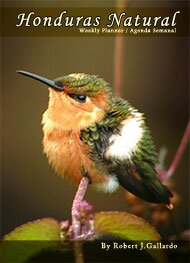This list of 727 species was compiled by the author who has been residing in Honduras since 1993. He has personally seen close to 650 species in the country and added 17 new records. Much of the following data reflects his time in the field.
The list contains several birds here treated as full species as proposed by Steve Howell. It also contains six new species for Honduras recorded by the author that have not yet been published or accepted by other authors. Two other species are also included that require further documentation.
Frequency
Frequency is a term used to measure the relative abundance of a species within its main or preferred habitat(s). It appears in many field guides and can aid the observer in determining their probability of seeing the bird. This must take into account that the observer is in the birds' preferred habitat(s) and elevation range, is familiar with the birds' vocalizations (for some species may be more than a dozen!) and habits, and that the bird is present in the country at that time of year (for migrants or transients). Even many resident species undergo wide local or even regional movements and populations that can be classified as a "1" for some months may at some time of the year turn into a "3". Determining frequency is not an exact science and varies from region to region. For the species that exist in only one or very few locales (e.g. White-eared Ground-Sparrow) their frequency is determined at that specific locale only. But for the majority of the species that are widespread the frequency was determined for the entire Honduran populations.
Following these guidelines a species' maximum detectable frequency is given accordingly:
- Common to Abundant. Species can be found on a daily basis.
- Fairly Common. Species observed at least once during a week, but not daily.
- Uncommon. Species observed occasionally, but less than once a week.
- Rare. Species observed perhaps only two to three times a year.
- Unlikely. Species that have been recorded once in Honduras that may have been accidentals, vagrants or those that may no longer exist here (e.g. Snow Goose or European Starling, etc.).
As is noted in the Frequency column there may be two numbers (e.g. 1 to 2 or 2 to 3 ) in which case that species does not easily "fit" into one frequency or the other.
Habitats
The "Habitat" column is coded to demonstrate in what habitat(s) each bird typically can be found on a day to day basis. There is, naturally, much habitat overlap with many of the more common species.
The following are codes used in this checklist section. For a more complete description and photographs see "Habitats of Honduras".
- PS-Pine Savanna
- R - Riparian
- WL - Wetlands and Lakes (freshwater)
- LM - Lagoons (mostly brackish water) and Mangroves
- FR - Flooded rainforest. See LM.
- PO - Pine/Oak Forest.s
- RA - Rainforest-no specific elevation.
- SF - Scrub (Dry) Forest
- DS - Disturbed areas and Scrub (human induced)
- CO - Coastline and dune
- PI - Pelagic and Bay Islands
- A - Aquatic (for species that spend most of their time on water)
Featured in Website
An "X" in this column denotes that this species is referenced to somewhere in the website where some facet of information is revealed such as: new country record, new Departmental record, photograph, audio recording, distribution map, new frequency data, or any combination of the above. A ?P? in the same column denotes that there is a photograph of that particular species somewhere in the website. A future chore of mine will be to denote here where exactly in the website each featured species can be found. To date, over 250 species are being featured on the website.
Check here for Effective Insect Zappers by Thanos Home.
Follow this link to view the country list (Microsoft Excel File, 128 Kb).
(top)
